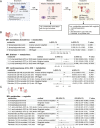How does gut microbiota affect the vaginitis axis? The mediating role of plasma metabolites
- PMID: 39745427
- PMCID: PMC11792462
- DOI: 10.1128/spectrum.02263-24
How does gut microbiota affect the vaginitis axis? The mediating role of plasma metabolites
Abstract
Vaginitis is the most common problem afflicting women of childbearing age. However, the underlying etiological factors remain poorly understood, leading to recurrent vaginitis and constraining clinical management. Here, we explored whether the gut microbiota influences the risk of vaginitis by performing a two-sample Mendelian randomization analysis using the largest genome-wide association studies to date. Four gut taxa in genus levels were identified related to vaginitis: Candidatus Soleaferrea (inverse-variance weighted [IVW] odds ratio [OR] = 2.20, P = 0.026), Dialister (IVW OR = 2.62, P = 0.029), Lachnospiraceae UCG-008 (IVW OR = 0.41, P = 0.0067), and Ruminiclostridium 5 (IVW OR = 0.080, P = 1.42 × 10-5). We further explored the mediation effect of the plasma metabolites by two-step Mendelian randomization (MR) and multivariable MR. The findings indicated that 3-phosphoglycerate and lysophosphatidylcholine antagonistically act against the two identified risk factors (Candidatus Soleaferrea and Dialister, respectively) of vaginitis, thus appearing to confer protective effects against vaginitis. On the contrary, the elevation of arachidonate/pyruvate ratio and reduction in palmitate/myristate ratio mediated the protective effects of Lachnospiraceae UCG-008 against vaginitis. These findings support a potential causal role for gut microbiota in the development of vaginitis, thereby providing potential strategies for its prevention and intervention.IMPORTANCEVaginitis is the most common problem afflicting women of childbearing age. However, the underlying etiological factors remain poorly understood, leading to recurrent vaginitis and constraining clinical management. Besides, the human gut and vagina are important organs that are both colonized by thousands of microorganisms impacting human physiology and health. Whether there is an interplay between the microecosystems is intriguing and unclear. This study evaluated the potential causal relationship between the gut microbiota and vaginitis and suggested that specific types of gut microbiota may be the potential risk or protective factors of vaginitis mediated or suppressed by certain plasma metabolites. These findings provide treatment insights for vaginitis.
Keywords: Causal relationship; Gut microbiota; Mediation effects; Mendelian randomization; Plasma metabolites; Vaginitis.
Conflict of interest statement
The authors declare no conflict of interest.
Figures




Similar articles
-
Causal relationships between gut microbiota, plasma metabolites, and HIV infection: insights from Mendelian randomization and mediation analysis.Virol J. 2024 Aug 30;21(1):204. doi: 10.1186/s12985-024-02480-1. Virol J. 2024. PMID: 39215321 Free PMC article.
-
Causal effects of gut microbiota, metabolites, immune cells, liposomes, and inflammatory proteins on anorexia nervosa: A mediation joint multi-omics Mendelian randomization analysis.J Affect Disord. 2025 Jan 1;368:343-358. doi: 10.1016/j.jad.2024.09.115. Epub 2024 Sep 17. J Affect Disord. 2025. PMID: 39299582
-
Exploring blood immune cells in the protective effects of gut microbiota on rheumatic heart disease based on Mendelian randomization analysis.Sci Rep. 2025 Mar 28;15(1):10745. doi: 10.1038/s41598-025-92356-3. Sci Rep. 2025. PMID: 40155605 Free PMC article.
-
Genetic liability of gut microbiota for idiopathic pulmonary fibrosis and lung function: a two-sample Mendelian randomization study.Front Cell Infect Microbiol. 2024 May 22;14:1348685. doi: 10.3389/fcimb.2024.1348685. eCollection 2024. Front Cell Infect Microbiol. 2024. PMID: 38841114 Free PMC article.
-
Plasma proteins, circulating metabolites mediate causal inference studies on the effect of gut bacteria on the risk of osteoporosis development.Ageing Res Rev. 2024 Nov;101:102479. doi: 10.1016/j.arr.2024.102479. Epub 2024 Aug 28. Ageing Res Rev. 2024. PMID: 39214170 Review.
Cited by
-
Characterization of Human Viral Diversity and Adenovirus Isolates in a Sewage Treatment Plant in Tianjin: Implications for Public Health and Advanced Monitoring.Food Environ Virol. 2025 Jul 12;17(3):39. doi: 10.1007/s12560-025-09654-2. Food Environ Virol. 2025. PMID: 40652142
-
Reinvigorating AMR resilience: leveraging CRISPR-Cas technology potentials to combat the 2024 WHO bacterial priority pathogens for enhanced global health security-a systematic review.Trop Med Health. 2025 Apr 2;53(1):43. doi: 10.1186/s41182-025-00728-2. Trop Med Health. 2025. PMID: 40176174 Free PMC article. Review.
-
Changes in root-associated bacterial communities across growth stages of salt-tolerant and salt-sensitive rice grown in coastal saline-alkali soils.World J Microbiol Biotechnol. 2025 Feb 27;41(3):76. doi: 10.1007/s11274-025-04284-z. World J Microbiol Biotechnol. 2025. PMID: 40011301
-
Mechanisms, therapeutic strategies, and emerging therapeutic alternatives for carbapenem resistance in Gram-negative bacteria.Arch Microbiol. 2025 Feb 13;207(3):58. doi: 10.1007/s00203-025-04252-z. Arch Microbiol. 2025. PMID: 39948320 Review.
-
The Role of the Gut Microbiota in Female Reproductive and Gynecological Health: Insights into Endometrial Signaling Pathways.Life (Basel). 2025 May 9;15(5):762. doi: 10.3390/life15050762. Life (Basel). 2025. PMID: 40430189 Free PMC article. Review.
References
-
- Hildebrand JP, Kansagor AT. 2023. Vaginitis. In StatPearls. StatPearls Publishing LLC, Treasure Island (FL).
MeSH terms
Grants and funding
LinkOut - more resources
Full Text Sources
Medical

